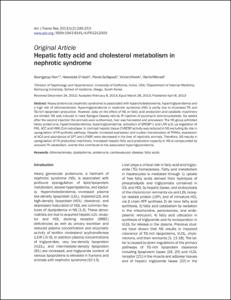KUMEL Repository
1. Journal Papers (연구논문)
1. School of Medicine (의과대학)
Dept. of Internal Medicine (내과학)
Hepatic fatty acid and cholesterol metabolism in nephrotic syndrome
- Keimyung Author(s)
- Han, Seung Yeup
- Department
- Dept. of Internal Medicine (내과학)
- Journal Title
- American Journal of Transplantation
- Issued Date
- 2013
- Volume
- 5
- Issue
- 2
- Abstract
- Heavy proteinuria (nephrotic syndrome) is associated with hypercholesterolemia, hypertriglyceridemia and
a high risk of atherosclerosis. Hypertriglyceridemia in nephrotic syndrome (NS) is partly due to increased TG and
TG-rich lipoprotein production. However, data on the effect of NS on fatty acid production and catabolic machinery
are limited. NS was induced in male Sprague Dawley rats by IP injection of puromycin aminonucleoside. Six weeks
after the second injection the animals were euthanized, liver was harvested and processed. The NS group exhibited
heavy proteinuria, hypercholesterolemia, hypertriglyceridemia, activation of SREBP-1 and LXR α/β, up-regulation of
FAS, ACC and HMG CoA reductase. In contrast hepatic tissue ChREBP activity was reduced in NS excluding its role in
upregulation of FA synthetic pathway. Despite increased expression and nuclear translocation of PPARα, expression
of ACO and abundance of CPT and L-FABP, were decreased in the liver of nephrotic animals. Therefore, NS results in
upregulation of FA production machinery. Increased hepatic fatty acid production capacity in NS is compounded by
reduced FA catabolism, events that contribute to the associated hypertiglyceridemia.
Keywords: Atherosclerosis, dyslipidemia, proteinuria, cardiovascular disease, fatty acids
- Keimyung Author(s)(Kor)
- 한승엽
- Publisher
- School of Medicine
- Citation
- Seungyeup Han et al. (2013). Hepatic fatty acid and cholesterol metabolism in nephrotic syndrome. American Journal of Transplantation, 5(2), 246–253.
- Type
- Article
- ISSN
- 1943-8141
- Appears in Collections:
- 1. School of Medicine (의과대학) > Dept. of Internal Medicine (내과학)
- 파일 목록
-
-
Download
 oak-aaa-00207.pdf
기타 데이터 / 744 kB / Adobe PDF
oak-aaa-00207.pdf
기타 데이터 / 744 kB / Adobe PDF
-
Items in Repository are protected by copyright, with all rights reserved, unless otherwise indicated.